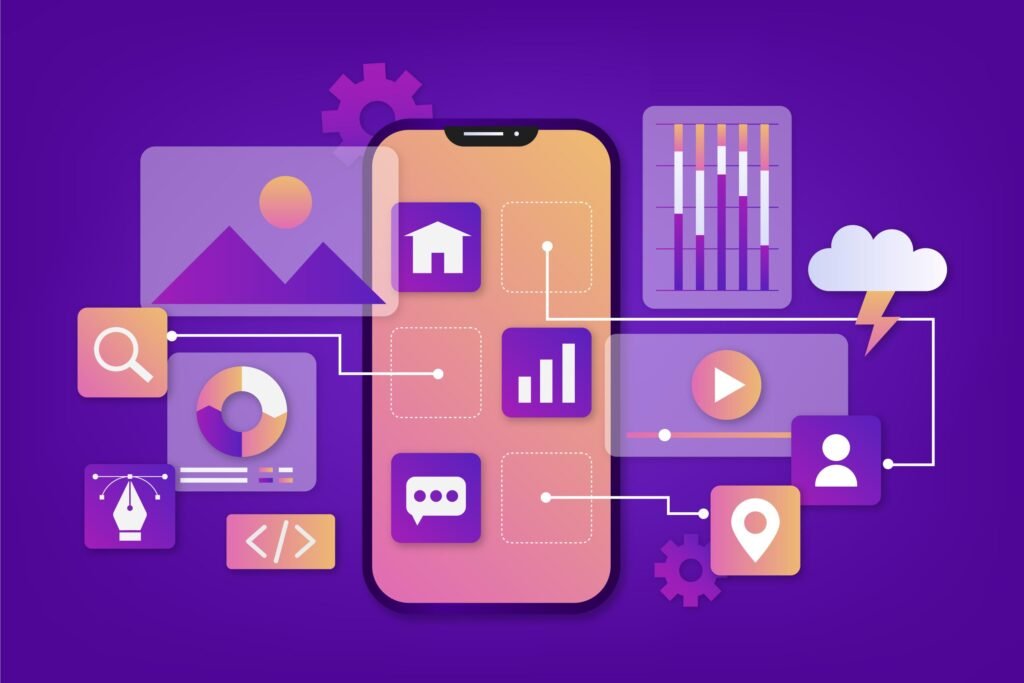
1. Hyper-Personalization through AI: In 2024, mobile app users expect experiences tailored specifically to them, and AI is playing a pivotal role in delivering this. Through AI and machine learning, apps are now analyzing user behavior, preferences, and interactions to create highly personalized UI layouts and content. From recommending products to customizing the app’s look and feel based on user preferences, hyper-personalization will define the way users interact with apps this year. This not only enhances engagement but also makes the overall experience feel intuitive and user-centric.
2. Immersive AR-Driven UI: Augmented Reality (AR) is becoming a key feature in mobile app design, offering immersive user experiences that blend the digital and real worlds. In 2024, AR-based UI will be widely integrated into shopping, gaming, and educational apps, allowing users to visualize products in real-world environments or interact with virtual objects. The ability to “try before you buy,” like seeing how furniture fits in your living room or virtually trying on clothes, is transforming the shopping experience. Designers are increasingly crafting UIs that are simple and intuitive while incorporating AR to engage users deeply.
3. Minimalist and Intuitive Interfaces: Minimalism continues to reign in mobile app UI/UX design, but in 2024, it’s evolving into a more functional minimalism. Designers are focusing on delivering streamlined, clutter-free interfaces that prioritize usability. By using clean layouts, fewer distractions, and bold typography, users can focus on core functions without feeling overwhelmed. This trend also aligns with faster loading times and better performance, making the overall user experience smoother and more enjoyable. With intuitive interfaces, users can quickly find what they need, reducing cognitive load and enhancing satisfaction.
“2024 is the year where personalization, simplicity, and immersive experiences will define mobile app UI/UX, creating user journeys that are intuitive, engaging, and truly human-centered.”
The rise of bezel-less and larger screens has shifted mobile app design toward gesture-driven navigation. Swiping, tapping, and pinching have become more intuitive, replacing traditional navigation buttons. In 2024, designers will continue to refine gesture-based UI to make interactions more fluid and natural. This reduces screen clutter and enhances the overall experience by creating more room for content. A well-designed gesture-driven interface feels more interactive and seamless, allowing users to navigate apps effortlessly.
4. Microinteractions for Delightful UX: Microinteractions—small, subtle animations or feedback that respond to user actions—are becoming more important in mobile app design. In 2024, expect to see more apps using microinteractions to provide instant, visual feedback during key moments such as tapping a button, pulling to refresh, or completing a task. These tiny details enhance the user experience by making the app feel more responsive and engaging. Well-crafted microinteractions create a sense of delight and make users feel more connected to the app.
5. Dark Mode Refinement: Dark mode has become a standard feature in most apps, but in 2024, designers will continue to refine its implementation. Rather than just flipping colors, dark mode will be optimized for readability and eye comfort. Designers will focus on choosing the right contrast, colors, and typography to ensure a visually comfortable experience, especially in low-light environments. This trend reflects a greater emphasis on user well-being and accessibility, as dark mode can reduce eye strain and extend battery life on mobile devices.
6. Voice-Activated UIs: Voice-activated interfaces are becoming a vital part of mobile app UI/UX design, providing users with hands-free navigation options. In 2024, more apps will integrate voice controls to enhance accessibility and multitasking. Whether for searching, setting reminders, or performing actions within the app, voice commands offer a faster, more convenient way for users to interact. This trend opens up new possibilities for simplifying navigation and improving user experience, particularly for people with disabilities or those who prefer voice-driven interaction.